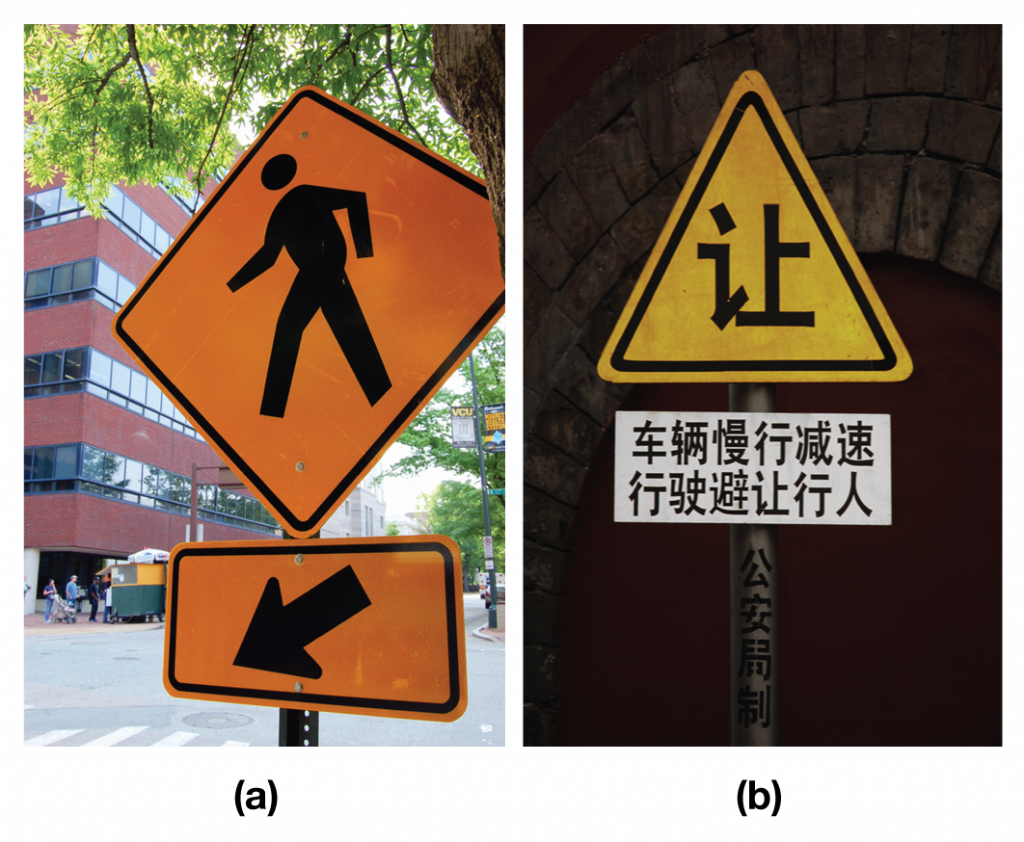3.2. Elements of Culture
Values and Beliefs
Two crucial elements that define the variability between cultures are values and beliefs. Values are a culture’s standard for discerning desirable states in society (what is true, good, just, or beautiful). They are “culturally defined goals, purposes, and interests,” which comprise “a frame of aspirational reference” as Robert Merton put it (Merton, 1938). Values are deeply embedded and critical for transmitting and teaching a culture’s beliefs. Beliefs are tenets or convictions that people hold to be true. Individuals in a society have specific beliefs, but they also share collective values.
To illustrate the difference, North Americans commonly believe that anyone who works hard enough will be successful and wealthy. Underlying this belief is the value that both work and wealth are good and desirable. In contrast, the Chinese Taoist concept of wu wei (not-doing or not-making) is based on the belief that “the way of things in the world” (the Tao) unfolds spontaneously. Therefore learning how to “not-work” and to allow life to unfold in the integrated and spontaneous way natural to it, without deliberate effort, is seen as a virtue (te) and is a shared, collective value.
Values help shape a society by suggesting what is good and bad, beautiful and ugly, and what should be sought or avoided. Consider the value that North American culture places upon youth. Children represent innocence and purity, while a youthful adult appearance signifies liveliness and sexuality. Shaped by this value, North Americans spend millions of dollars each year on cosmetic products and surgeries to look young and beautiful.
Sometimes the values of Canada and the United States are contrasted. Americans are said to have an individualistic culture, meaning people place a high value on individuality and independence. In contrast, Canadian culture is said to be more collectivist, meaning the welfare of the group and group relationships are primary values. As described below, Seymour Martin Lipset used these contrasts of values to explain why the two societies, which have common roots as British colonies, developed such different political institutions and cultures (Lipset, 1990).
Values are not static; they vary across time and between groups as people evaluate, debate, and change collective societal beliefs. For example, the change in the laws (the Cannabis Act) governing cannabis use in Canada shifted from prohibition to legalization and regulation in October, 2018, largely because of a change in the underlying values of Canadians. Where cannabis consumption had been presented as a sign of immoral character in the early 20th century campaigns to prohibit it, law makers in the 21st century recognized that a majority of the population disagreed. Many in fact regarded it as medicinal, as a means to attain the positive value of health and well-being. Others regarded it as matter of personal choice or right within a sphere of personal autonomy that should not be interfered with by moral authorities or states. It appears that Canadian values changed priority: from the virtue of abstinence to the virtues of health or personal autonomy.
Sociology is interested in the role values play in social life. Practically speaking, values influence or guide choices of action. A person will choose to act in one way rather than another because of their values. However, as described in Chapter 2. Sociological Research, the classical sociologist Harriet Martineau (1838) made a basic distinction between what people say they believe in or value and what they actually do, which are often at odds. Values often suggest how people should behave, but they do not accurately reflect how people do behave. It is easy to value good health, but it is hard to quit eating chips. Marital monogamy is valued, but many spouses engage in infidelity. Regardless, values (1) affect how one perceives or feels towards things (i.e.,they have a significant emotional content); (2) provide a “vocabulary of motives” that allows one to interpret and explain one’s own and other’s behaviour; and (3) create a basis for shared commonalities and trust — Durkheim’s “collective conscience” — that allow cooperation to take place through time. When values are not shared, there is mistrust, which makes collective concerted action more difficult (Thome, 2015).
Norms
So far, the examples in this chapter have often described how people are expected to behave in certain situations — for example, when buying food or boarding a bus. These examples describe the visible and invisible rules of conduct through which societies are structured, or what sociologists call norms. As opposed to values and beliefs which identify desirable states and convictions about how things are, a norm is a generally accepted way of doing things. Norms define how to behave in accordance with what a society values and has defined as good, right, and important. They define the rules that govern behaviour.
Just as values vary from culture to culture, so do norms. For example, cultures differ in their norms about what kinds of physical closeness are appropriate in public. It is rare to see two male friends or coworkers holding hands in Canada where that behaviour often symbolizes romantic feelings. But in many nations, masculine physical intimacy is considered natural in public. A simple gesture, such as hand-holding, carries great symbolic differences across cultures.

Most members of the society adhere to norms because their violation invokes some degree of sanction. Sanctions are a form of social control, a way to encourage conformity to cultural norms. They define the punishments and rewards that govern behaviour. These can be understood to operate at various levels of formality.
Formal norms are established, written rules. They are behaviours worked out and agreed upon in order to suit and serve most people. Laws are formal norms, but so are employee manuals, college entrance exam requirements, and the “no running” rule at swimming pools. Formal norms are the most specific and clearly stated of the various types of norms, and the most strictly enforced. But even formal norms are enforced to varying degrees, reflected in cultural values.
For example, money is highly valued in North America, so monetary crimes are punished. It is against the law to rob a bank, and banks go to great lengths to prevent such crimes. People safeguard valuable possessions and install anti-theft devices to protect homes and cars. Until recently, a less strictly enforced social norm was driving while intoxicated. While it is against the law to drive drunk, drinking is for the most part an acceptable social behaviour. Though there have been laws in Canada to punish drunk driving since 1921, there were few systems in place to prevent the crime until quite recently. These examples show a range of enforcement in formal norms.
There are plenty of formal norms, but the list of informal norms — casual behaviours that are generally and widely conformed to — is longer. People learn informal norms by observation, imitation, and general socialization. Some informal norms are taught directly — “kiss your Aunt Edna” or “use your napkin” — while others are learned by observation, including observations of the consequences when someone else violates a norm. Children learn quickly that picking their nose is subject to ridicule when they see someone shamed by others for doing it. Although informal norms define personal interactions, they extend into other systems as well. Think back to the discussion of fast food restaurants at the beginning of this chapter. In Canada, there are informal norms regarding behaviour at these restaurants. Customers line up to order their food, and leave when they are done. They do not sit down at a table with strangers, sing loudly as they prepare their condiments, or nap in a booth. Most people do not commit even benign breaches of informal norms. Informal norms dictate appropriate behaviours without the need of written rules.
Robert Merton’s (1938) famous essay “Social Structure and Anomie” illustrates the difference and also some of the contradictions between values and norms. He argues that, in North American society, a common value is the accumulation of wealth as a sign of success. Success through possession of wealth is a value that “comprises a frame of aspirational reference.” However at the same time he notes that, in a class and racially divided society, access to legitimate means of accumulating wealth is not equally distributed. “Social structure defines, regulates, and controls the acceptable modes of achieving these goals.” These “acceptable modes” are defined by norms, the “permissible and required procedures for attaining these ends,” and backed up with moral and institutional regulations. As a result, Merton argued that a social strain is built in to the structure of society in which people without access to inheritance, higher education, good jobs, stable living conditions, etc. are forced to either abandon the goal of success or choose illegitimate means like crime to attain it (see Robert Merton: Strain Theory in Chapter 6. Social Interaction). Crime is therefore the natural outcome of the contradiction between the value of success and the norms to achieve it.
The extreme emphasis upon the accumulation of wealth as a symbol of success in our own society militates against the completely effective control of institutionally regulated modes of acquiring a fortune. Fraud, corruption, vice, crime, in short, the entire catalogue of proscribed behavior, becomes increasingly common when the emphasis on the culturally induced success-goal becomes divorced from a coordinated institutional emphasis (Merton, 1938).
Making Connections: Sociological Research
Breaching Experiments

Sociologist Harold Garfinkel (1917-2011) studied people’s everyday interactions in order to find out how tacit and often unconscious societal rules and norms not only influenced behaviour but enabled the social order to exist (Weber, 2011). Like the symbolic interactionists, he believed that members of society together create a working consensus in different situations which produces social order. He noted, however, that people often draw on inferred knowledge and unspoken agreements to do so. His resulting book, Studies in Ethnomethodology (1967), discusses the underlying assumptions and tacit knowledges that people rely on to navigate and make sense of the world. Ethnomethodology is a paradigm of interpretive sociology that studies “the body of common-sense knowledge and the range of procedures and considerations by means of which ordinary members of society make sense of, find their way about in, and act on the circumstances in which they find themselves” (Heritage, 1984).
One of his research methods was known as a breaching experiment. His breaching experiments tested sociological concepts of social norms and conformity. In a breaching experiment, the researcher purposely breaks a social norm or behaves in a socially awkward manner. The participants are not aware an experiment is in progress. If the breach is successful, however, these innocent bystanders will respond in some way. For example, he had his students go into local shops and begin to barter with the sales clerks for fixed price goods. “This says $14.99, but I’ll give you $10 for it.” Often the clerks were shocked or flustered because the common sense norms of shopping had been broken. This breach reveals the unspoken convention in North America that the amount given on the price tag is the price. It also breaks a number of other unspoken conventions which seek to make commercial transactions as efficient and impersonal as possible. How people respond to restore order or to provide an account of the norm violation that makes the situation “make sense” was a focus of these experiments.
In another example, he had his students engage an acquaintance in conversation, but insist that the acquaintance clarify commonplace remarks. So in response to the question, “How is your girlfriend feeling?” one student experimenter responded “What do you mean, ‘How is she feeling?’ Do you mean physical or mental?” and so on. The exchange ended with the acquaintance feeling flustered, “What’s the matter with you? Are you sick?” In this case, the unspoken norm was the rule that people should not have to explain themselves in ordinary conversation. “What they are saying is understandable and ought to be understood” (Garfinkel, 1967). Certain things ‘go without saying,’ but what things, and why? How are things that “go without saying” communicated or known?
Even though ordinary conversation is often ambiguous and full of gaps the norm is that each participant should go along with the understanding that everything is perfectly understood. If they do not go along they face consequences. The unspoken rules of common sense knowledge are very real in this sense. Moreover they have the character of a “self-fulfilling prophecy” to the degree that they are reinforced over and over again by “persons’ motivated compliance with these background expectancies” (Garfinkel, 1967). One has to “go along to get along.”
The point of the experiments was not that the experimenter would simply act obnoxiously or weird in public. Rather, the point is to deviate from a specific social norm in a small way, to subtly break some form of social etiquette or common speech, and see what happens. Garfinkel suspected that odd behaviours would shatter conventional expectations, but he was not sure how. The reactions of outrage, anger, puzzlement, or other emotions to the breaking of relatively trivial norms, illustrated the deep level of unconscious investment people have in keeping this web of tacit conventions intact. They are essential in maintaining a common, shared sense of the orderliness and predictability of the world. Without them subjects were often flustered. The social situation threatened to become completely senseless unless the breach was rectified. To challenge the known-in-common background — “what should be plain for everyone to see” — leads to bewilderment. The take away is that society itself is only possible to the degree that bewilderment is kept at bay.
There are many rules about speaking with strangers in public. It is okay to tell a woman you like her shoes. It is not okay to ask if you can try them on. It is okay to stand in line behind someone at the ATM. It is not okay to look over their shoulder as they make the transaction. It is okay to sit beside someone on a crowded bus. It is weird to sit beside a stranger in a half-empty bus. These cultural norms play an important role. They let people know how to behave around each other and how to feel comfortable in our community, but they are not necessarily rational. Why should we not talk to someone in a public bathroom, or haggle over the price of a good in a store? Breaching experiments uncover and explore the many unwritten social rules people live by. They indicate the degree to which the world people live in is fragile, arbitrary, and ritualistic; socially structured by deep, silent, tacit agreements with others of which people are frequently only dimly aware.
Folkways, Mores, and Taboos
Norms may be further classified as mores, folkways, or taboos. Mores (pronounced mor–ays) are norms that embody the moral views and principles of a group. They are based on social requirements. Violating them can have serious consequences. The strongest mores are legally protected with laws or other formal norms. In Canada, for instance, murder is considered immoral, and it is punishable by law (a formal norm). More often, mores are judged and guarded by public sentiment (an informal norm). People who violate mores are seen as shameful. They can even be shunned or banned from some groups. The mores of the Canadian school system require that a student’s writing be in the student’s own words or else the student should use special stylistic forms such as quotation marks and a system of citation, like APA (American Psychological Association) or MLA (Modern Language Association) style, for crediting the words to other writers. Writing another person’s words as if they are one’s own has a name: plagiarism. The consequences for violating this norm are severe, and can even result in expulsion.
Unlike mores, folkways are norms without any moral underpinnings. They are based on social preferences. Folkways direct appropriate behaviour in the day-to-day practices and expressions of a culture. Folkways indicate whether to shake hands or kiss on the cheek when greeting another person. They specify whether to wear a tie and a blazer or a T-shirt and sandals to an event. In Canada, women can smile and say hello to men on the street. In Egypt, it is not acceptable. In northern Europe, it is fine for people to go into a sauna or hot tub naked. Often in North America, it is not. An opinion poll that asked Canadian women what they felt would end a relationship after a first date showed that women in British Columbia were pickier than women in the rest of the country (Times Colonist, 2014). First date deal breakers included poor hygiene (82%), being distracted by a mobile device (74%), talking about sexual history and being rude to waiters (72%), and eating with one’s mouth open (60%). All of these examples illustrate breaking informal rules, which are not serious enough to be called mores, but are serious enough to terminate a relationship before it has begun. Folkways might be small manners, but they are by no means trivial.
Taboos refer to actions which are strongly forbidden by deeply held sacred or moral beliefs. They are the strongest and most deeply held norms. Their transgression evokes revulsion and severe punishment. In its original use taboo referred to being “consecrated, inviolable, forbidden, unclean, or cursed” (Cook & King, 1784). There was a clear supernatural context for the prohibition; the act offended the gods or ancestors, and evoked their retribution. In secular contexts, taboos refer to powerful, moral prohibitions that protect what are regarded as inviolable bonds between people. Incest, pedophilia, and patricide or matricide are taboos.
Many mores, folkways, and taboos are taken for granted in everyday life. People need to act without thinking to get seamlessly through daily routines; they can not stop and analyze every action (Sumner, 1906). They become part of routines, or cultural practices. As Dorothy Smith (1999) put it, the different levels of norm enable the “ongoing concerting and coordinating of individuals’ activities.” These different levels of norm help people negotiate their daily life within a given culture, and as such their study is crucial for understanding the distinctions between different cultures.
Practices
Even an action as seemingly simple as commuting to work evidences a great deal of cultural propriety. Take the case of going to work on public transportation. Whether commuting in Dublin, Cairo, Mumbai, or Vancouver, many behaviours will be the same in all locations, but significant differences also arise between cultures. Typically in Canada, a passenger finds a marked bus stop or station, waits for the bus or train, pays an agent before or after boarding, and quietly takes a seat if one is available. But when boarding a bus in Cairo, passengers might have to run, because buses there often do not come to a full stop to take on patrons. Dublin bus riders are expected to extend an arm to indicate that they want the bus to stop for them. When boarding a commuter train in Mumbai, passengers must squeeze into overstuffed cars amid a lot of pushing and shoving on the crowded platforms. That kind of behaviour would be considered the height of rudeness in Canada, but in Mumbai it reflects the daily challenges of getting around on a train system that is taxed to capacity.
In this example of commuting, the different cultural practices are seen as various solutions to a common problem, the problem of public transportation by bus. The problem is shared, but the solutions are different. Practices in general are simply ways of doing things. The idea of a cultural practice indicates that a way of doing things is embedded in a particular culture. They express a particular way of seeing and interpreting the world, a particular type of know-how or practical knowledge, a particular set of social expectations and constraints, and a particular set of customs or traditions.
Symbols and Language

Humans, consciously and subconsciously, are always striving to make sense of their surrounding world. Symbols — such as gestures, signs, objects, signals, and words — are tangible marks that stand in for, or represent, something else in an act of communication. Through symbols an understanding of underlying experiences, statuses, states, and ideas is expressed and can be passed from one person to another. They symbolize these underlying contents and convey them as recognizable markers of meaning shared by societies. They are therefore necessarily social, otherwise they could not be used to communicate. In the words of George Herbert Mead (1934):
Our symbols are universal. You cannot say anything that is absolutely particular, anything you say that has any meaning at all is universal.
The social world is filled with symbols. Sports uniforms, company logos, and traffic signs are symbols. In North America, a gold ring on the fourth finger of the left hand is a symbol of marriage. In many European countries the wedding ring is worn on the right hand. Some symbols are highly functional; stop signs, for instance, provide useful instruction. A police officer’s badge and uniform are symbols of authority and law enforcement. The sight of a police officer in uniform or in a police car triggers reassurance in some citizens, but annoyance, fear, or anger in others. Some symbols are only valuable in what they represent. Trophies, blue ribbons, or gold medals, for example, serve no purpose other than to represent accomplishments.

It is easy to take symbols for granted. Few people challenge or even think about the signs on the doors of public restrooms, but the figures on the signs are more than just symbols that tell men and women which restroom to use. They also uphold the value, in North America, that public restrooms should be gender exclusive. Even though stalls are relatively private, it is still somewhat uncommon to encounter unisex bathrooms.

Symbols often get noticed when they are used out of context. Used unconventionally, symbols convey strong messages. A stop sign on the door of a corporation makes a political statement, as does a semi-truck used as a baricade in a protest. Together, the semaphore signals for “N” and “D” represent nuclear disarmament and form the well-known peace sign (Westcott, 2008). Internet memes — images that spread from person to person through reposting — often adopt the tactics of detournement or misappropriation used by the French Situationists of the 1950s and 1960s. The Situationists sought to subvert media and political messages by altering them slightly — “detouring” or hijacking them — in order to defamiliarize familiar messages, signs, and symbols. An ordinary image of a cat combined with the grammatically-challenged caption “I Can Has Cheezburger?” spawned the internet phenomenon “lolcats” because of the funny, nonsensical nature of its non sequitur message.
Even the destruction of symbols is symbolic. Effigies representing public figures are beaten or burned to demonstrate anger at certain leaders. In 1989, crowds tore down the Berlin Wall, a decades-old symbol of the division between East and West Germany, that was itself a symbol of the “Cold War” between communist and capitalist political blocs.
Language
While different cultures have varying systems of symbols, there is one that is common to all: the use of language. Language is a symbolic system through which people communicate and through which culture is transmitted. Some languages contain a system of symbols used for written communication, while others rely only on spoken communication and nonverbal actions.
For Emile Durkheim (1938), language is a prime example of a social fact. It exists only in people’s heads or in their usage of it, yet it exists externally to them “in its own right.” Language acts as an external constraint, it operates throughout a whole society and exists as an entity independent of its individual manifestations. Languages in a strange way are not created by individuals. They precede the individual and continue to exist after the individual is gone. They frequently impose detailed obligations on the individual that they are unaware of (vocabulary or the rules of correct word usage and grammar, for example). They operate independently of people’s wills as if endowed with an external coercive power that controls them (determining what can and cannot be said, or even what can and cannot be thought, for example), rather than the other way around. By entering into language, a child enters into a whole conceptual order in which a place — that of the “child” and the meanings of “child” — is already laid out for them.
Some elements of language are fixed by codes. A code is a set of cultural conventions, instructions, or rules used to combine symbols to communicate meaning. Like the codes used in ciphers to encode secret messages, the sender of a message and the receiver of a message have to share the same instructions for how to encode and decode a message correctly or else communication cannot occur. Codes therefore govern combinations of symbols that are permitted (and thereby make sense) and combinations which are forbidden (and thereby produce nonsense).

Grammatical codes for example are sets of instructions that structure the choice of words — nouns, verbs, adjectives, prepositions, pronouns, adverbs, conjunctions, etc. — that can be combined to make a meaningful sentence. “The boy cried” is coded correctly and conveys a clear image. “Boy the cried” is incorrectly coded and conveys no image. But codes are often more culturally complex than this in the sense that communication depends on being able to combine and interpret numerous cultural conventions, meanings, symbols, and connotations. For example, in a famous analysis of a Panzani pasta ad, Roland Barthes (1977) noted that in order to “get” the ad one had to be able to read the codes that signified the product’s “Italianness” and associate the product with the freshness of ripe tomatoes and the freedom of shopping in outdoor markets. People competently decode these types of message everyday. But how do they do it? How do they know the instructions that let them decode the messages?

One type of deep cultural code that fixes the meaning of language is the binary opposition. A binary opposition is a set of paired terms, considered as mutually exclusive and logical opposites, which structure a whole set or system of meanings. “Male/female” structures how people think about gender. “Culture/nature” structures how people think about their relationship to nature. “Us/them” structures how people think about politics. Usually in a society one term in the binary opposition is privileged over another in a way that makes the inequalities that structure institutional organization seem natural. However, there are no binary oppositions in nature. They are products of a cultural distinction.
Durkheim already noted how the opposition between sacred/profane — things that were holy and things that were ordinary — was the central organizing structure or code that defined all religion (see Chapter 15. Religion). The anthropologist Claude Levi-Strauss (1978) expanded on this to argue that irreconcilable opposites were at the heart of all cultural systems. They were “the invariant elements among superficial differences” (Levi-Strauss, 1978). This explained the underlying similarities in myths observed in the ethnographic record between vastly divergent groups. Levi-Strauss argued that myths use stories to resolve problems of binary opposition that are common to the human condition: How are animals and gods different than humans? Why are some people heroes and other people villains? How can humans survive in a harsh and unpredictable nature? The analysis of deep structures of meaning like binary oppositions behind the manifestations of culture — stories, belief systems, values, practices, etc. — became known as structuralism.
Language is also constantly evolving. Rules for speaking and writing vary even within cultures, most notably by region and level of formality. Does one refer to a can of carbonated liquid as a soda, pop, or soft drink? When leaving a restaurant, does one ask the server for the cheque, the ticket, l’addition, or the bill? Language also changes as societies create new ideas. In this age of social media technology, people have adapted almost instantly to new nouns such as email, internet and cyberspace, and verbs such as download, text, tweet, google, and blog. Thirty years ago, the general public would have considered these words gibberish.

Even while it constantly evolves, language continues to act as a “social fact” to shape social reality. This insight was established in the 1920s by two linguists, Edward Sapir and Benjamin Whorf. They believed that reality is culturally determined, and that any interpretation of reality is based on a society’s language. To prove this point, the sociologists argued that every language has words or expressions specific to that language. In Western societies, for example, the number 13 is associated with bad luck. Fear of Friday the 13th is referred to as paraskevidekatriaphobia, high rise buildings often do not have 13th floors, and some evidence even indicates that hospital admissions due to traffic accidents increase on Friday the 13th (Scanlon et al., 1993). In many Asian societies, however, the number four is considered unlucky, since it is pronounced similarly to the word for death in many Asian languages. Consequently, buildings often do not have a fourth floor, it is difficult to buy things in sets of four and some research indicates that Asian people are more likely to have heart attacks on the 4th of the month (Phillips et al., 2001).
The Sapir-Whorf hypothesis is based on the idea that people experience their world through their language and that they, therefore, understand the world through the culture embedded in their language. The hypothesis, which has also been called linguistic relativity, states that people initially develop language to express concepts that emerge from their direct experience of the world, but afterwards language as a system of meaning comes back to shape their experience of the world (Swoyer, 2003). Studies have shown, for instance, that unless people have access to the word “ambivalent,” they do not recognize an experience of ambivalence due to conflicting positive and negative feelings about one issue. If a person cannot describe the experience, the person cannot have the experience.
Similarly, at the beginning of this chapter, in Wade Davis’ (2007) discussion about the ethnosphere — the sum total of “ways of thinking, ways of being, and ways of orienting oneself on the earth” — each language is understood to be more than just a set of symbols and linguistic rules. Each language is an archive of a culture’s unique cosmology, wisdom, ecological knowledge, rituals, beliefs and norms. Each contributes a unique solution to the question of what it means to be human.
The compilers of Ethnologue estimate that currently 7,105 languages are used in the world (Lewis et al., 2013). This would suggest that there are at least 7,105 distinct cultural contexts through which humans interpret and experience the world. The Sapir-Whorf hypothesis would suggest that their worlds differ to the degree that their languages differ. However Davis notes that today half of the world’s languages are no longer being passed down to children. When languages die out or fail to be passed on to subsequent generations, whole ways of knowing and being in the world die out with them and the ethnosphere is diminished. Norris (2007) reports that at least 10 once flourishing Indigenous languages have become extinct in Canada over the past 100 years. Of the 11 remaining Indigenous language families, 7 were listed as endangered, mostly endangered or uncertain.
Making Connections: Sociology in the Real World
Is Canada Bilingual?

In the 1960s it became clear that the federal government needed to develop a bilingual language policy to integrate French Canadians into the national identity and prevent their further alienation. The Royal Commission on Bilingualism and Biculturalism (1965) recommended establishing official bilingualism within the federal government. As a result, the Official Languages Act became law in 1969 and established both English and French as the official languages of the federal government and federal institutions such as the courts. Pierre Elliott Trudeau’s governments of the late 1960s and early 1970s had an even broader ambition: to make Canada itself bilingual. Not only would Canadians be able to access government services in either French or English, no matter where they were in the country, but also receive French or English education. The entire country would be home for both French or English speakers (McRoberts, 1997).
However, in the 1971 census 67% of Canadians spoke English most often at home, while only 26% spoke French at home and most of those were in Quebec. Approximately 13% of Canadians could maintain a conversation in both languages (Statistics Canada, 2007). Outside Quebec, the province with the highest proportion of people who spoke French at home was New Brunswick at 31.4%. The next highest were Ontario at 4.6% and Manitoba at 4%. In British Columbia, only 0.5% of the population spoke French at home. French speakers had widely settled Canada, but French speaking outside Quebec had lost ground since Confederation because of the higher rates of anglophone immigrants, the assimilation of Francophones, and the lack of French-speaking institutions outside Quebec (McRoberts, 1997). It seemed even in 1971 that the ideal of creating a bilingual nation was unlikely and unrealistic.
What has happened to the concept of bilingualism over the last 50 years? According to the 2011 census, 58% of the Canadian population spoke English at home, while only 18.2% spoke French at home. Proportionately the number of both English and French speakers has actually decreased since the introduction of the Official Languages Act in 1969. On the other hand, the number of people who can maintain a conversation in both official languages has increased to 17.5% from 13% (Statistics Canada, 2007). However, the most significant linguistic change in Canada has not been French-English bilingualism, but the growth in the use of languages other than French and English. In a sense, what has happened is that the shifting cultural composition of Canada has rendered the goal of a bilingual nation anachronistic.
Today it would be more accurate to speak of Canada as a multilingual nation. One-fifth of Canadians speak a language other than French or English at home; 11.5% report speaking English and a language other than French, and 1.3% report speaking French and a language other than English. In Toronto, 32.2% of the population speak a language other than French and English at home: 8.8% speak Cantonese, 8% speak Punjabi, 7% speak an unspecified dialect of Chinese, 5.9% speak Urdu, and 5.7% speak Tamil. In Greater Vancouver, 31% of the population speak a language other than French and English at home: 17.7% of whom speak Punjabi, followed by 16.0% who speak Cantonese, 12.2% who speak an unspecified dialect of Chinese, 11.8% who speak Mandarin, and 6.7% who speak Philippine Tagalog.
Today, the government of Canada still conducts business in both official languages. French and English are the dominant languages in the workplace and schools. Labels on products are required to be in both French and English. But increasingly a lot of product information is also made available in multiple languages. In Vancouver and Toronto, and to a lesser extent Montreal, linguistic diversity has become increasingly prevalent. French and English are still the central languages of convergence and integration for immigrant communities who speak other languages — only 1.8% of the population were unable to conduct a conversation in either English or French in 2011 — but increasingly Canada is linguistically diverse rather than bilingual in the two official languages.

Media Attributions
- Figure 3.16 Soldiers Holding Hands by Geordie Mott, via Wikimedia Commons, is used under a CC BY 2.0 licence.
- Figure 3.17 Garfinkel2 by Arlene Garfinkel, via Wikipedia, is used under a CC BY 3.0 licence.
- Figure 3.18 Photo (a) Pedestrians Right There by Andrew Bain; photo (b) Traffic sign by HonzaSoukup, via Flickr are used under a CC BY 2.0 licence.
- Figure 3.19 Unisex Toilet by Bart Maguire, via Flickr, is used under a CC BY-NC-ND 2.0 licence.
- Figure 3.20 Détourned no-entry sign in Barcelona (img_5845) by acb, via Flickr, is used under a CC BY-NC-SA 2.0 licence.
- Figure 3.21 Panzani ad by Roland Barthes (1977), via Academia, is used under Fair Dealing provisions of the Canadian Copyright Act.
- Figure 3.22 Undecided by Jeff Golden, via Flickr, is used under a CC BY-SA 2.0 licence.
- Figure 3.23 Elevator buttons by Dushan Hanuska, via Flickr, is used under a CC BY-SA 2.0 licence.
- Figure 3.24 Starbucks on Rue University, Montreal by 12th St David via Flickr is used under a CC BY-NC-SA 2.0 licence.
- Figure 3.25 Multilingual City by Michael Gil, via Flickr, is used under a CC BY 2.0 licence.

